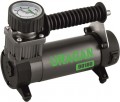Max. pressure
The maximum pressure provided by the pump or compressor — in other words, the highest tyre pressure that can be achieved using this unit.
In most models, this figure is
from 2.5 to 10 atm, and in mechanical pumps (manual and foot, see "Type") pressure of more than 10 atm is practically not found at all. This is due to the fact that even for heavy trucks, the optimal tyre pressure is usually about 5 – 9 atm (depending on a number of parameters — there are special formulas and tables for calculations); and in passenger car tyres, a pressure of more than 2.5 atm is extremely rarely used. However, there are compressors with higher pressure parameters —
11 – 15 atm,
16 – 20 atm and even
higher. The meaning of such characteristics is mainly in the "power reserve": a higher working pressure contributes to faster pumping. However, be careful not to over-inflate the tyre and damage it.
Current consumption
The amount of current drawn by the compressor during operation. For most models intended for use with passenger cars, this indicator is at the level of 12-14 A. A small current consumption is preferable from the point of view of energy saving, but the performance of the device largely depends on this indicator (see "Performance").
Hose length
The length of the hose through which air is pumped into the tyre. The larger it is, the more convenient the device is to use. But it is rare that the compressor is left far from the wheel, especially if a pressure gauge is placed on the device, which must be periodically checked. For domestic use in cars, a one and a half metre long hose is enough. Powerful and performant models can be equipped with a hose of 7 metres or more, but these are more solutions for commercial use in car services.

